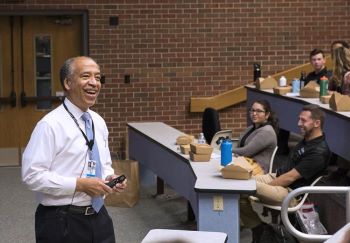Dean Willie Reed

Purdue University photo by Kevin Doerr
Purdue University isn’t the only institution holding tuition flat, but it’s done so the longest, coming up on a decade, says Dr. Willie Reed, dean of the College of Veterinary Medicine (foreground).
This is the second of three parts.
There are two ways for schools to alleviate the crushing student loan debt faced by veterinarians who enter the workforce owing loans twice their starting salaries, says Dr. Willie Reed, longtime dean of the Purdue University College of Veterinary Medicine.
"You hold tuition flat or increase scholarships," he stated firmly.
Purdue University, under the leadership of its famously frugal president, Mitch Daniels, has opted to do both, most notably by freezing tuition across campus in West Lafayette, Indiana, for a decade.
The objective — which keeps veterinary tuition and fees for Indiana residents at around $20,000 a year and $44,700 a year for nonresidents, with the occasional fee increase — is aimed at making education more affordable, particularly for those who live in the state. In the veterinary college, half of Purdue's students are Hoosiers.
Like many in the profession, Reed considers educational indebtedness to be the profession's Achilles heel, and supports his institution's commitment to affordability. Across the country, veterinary education is more expensive than ever — between $19,616 and $72,292 a year in tuition and fees, depending on the program and student's residency status — which leaves most aspiring practitioners with a difficult choice: forgo their dream career or risk accumulating sky-high debt.
Neither is acceptable, as far as Reed's concerned: "Not pricing people out of an education — that's so important."
It's not easy. While Daniels advances an affordability mission, Reed has to balance a $75 million annual operating budget while in the midst of building a $108 million veterinary teaching hospital, slated to open in March. Helping his efforts is an $18 million annual state allocation that goes directly to the program. There's been an uptick in revenue from the existing teaching hospital and diagnostic laboratory, and donations from fundraising have increased "so we've been able to manage," Reed said.
Many other veterinary programs aren't as fortunate. State funding for higher education in general has not fully recovered from cuts made during the 2008 recession, which puts pressure on tuition revenue, according to a State Higher Education Finance report released this year. That means climbing tuition and more borrowing to pay for it. Total student loan debt across the U.S. is $1.71 trillion, spread among 45 million borrowers whose average monthly payments are about $300.
"Debt is steadily increasing, and that's not unique to veterinary medicine," Bridgette Bain, associate director for analytics at the American Veterinary Medical Association, said in a recent online symposium. "U.S. student debt has increased 100% over the past decade, across all disciplines.
"We certainly don't see tuition being reduced," she said.
Veterinary borrowers in 2020 averaged $188,853 of debt upon graduation — a 43% increase from 2011, according to figures from the AVMA. The greatest individual debt reported by fourth-year students who responded last year to an annual AVMA survey was half-a-million dollars.
vns bug

Average debt for Purdue's graduating veterinary class last year was $145,336, Reed said, and 88% of the class received aid from the university in the form of scholarships and grants.
"Universities don't roll back tuition," he said. "At the end of the day, for Purdue, I think keeping tuition flat was the best we could have hoped for. It's expensive to educate veterinary students."
Attending veterinary school at Purdue is less expensive than most of the 33 schools in the United States, the American Association of Veterinary Medical Colleges reports. Looking at 2020 data in the group's cost comparison tool, four years of in-state tuition at Purdue cost $80,734, the most affordable option for Indiana residents and the least-expensive program in the country when factoring in fees and living expenses. For nonresidents, the program ranked as the sixth most-economical option over four years, with tuition at $180,089; $284,492 when including living expenses.
A cost of education map by the VIN Foundation, a nonprofit arm of the Veterinary Information Network, parent of the VIN News Service, ranks Purdue similarly.
Just one U.S. program charges its residents less, according to AAVMC and VIN Foundation data: Four years of veterinary tuition at North Carolina State University is $78,479. The most expensive program in the country is at Midwestern University. The private four-year program in Glendale, Arizona, runs nearly $260,000 in tuition alone. Add living expenses and fees, and the overall cost to attend Midwestern could surpass $420,000.
Asked whether Purdue's flat tuition spurs curiosity among Reed's colleagues at other programs, the dean responded with amusement. "You would think I'd be inundated with questions from other colleges, but that's not the case," Reed laughed. "I don't think I've gotten a single question about how you do it.
"But that's all right," he continued. "We have a lot to be proud of. Our engagement office is securing multimillion grants from the NIH [National Institutes of Health]. Our diversity programs are outstanding: The last couple of classes have been 30% underrepresented minorities. And there's no end date on keeping our tuition flat. I don't see that going away anytime soon."
Last month, Purdue University trustees approved keeping tuition frozen through the 2022-23 academic year.
Easier said than done
Tackling the student debt crisis was cited as an objective of a new veterinary school, the University of Arizona College of Veterinary Medicine, during its early stages of development in 2016. The program opened last August with 100 students, becoming the 31st veterinary school in the country. Rather than follow a traditional four-year calendar, the University of Arizona's curriculum is compressed into three years, summers included, which ostensibly saves students time and money.
College officials initially aimed for tuition to be around $28,000 a year. They later determined that wasn't financially feasible, so the Arizona Board of Regents set tuition significantly higher: $45,000 a year for residents and $70,000 for nonresidents.
Dr. Julie Funk, hired as dean of the program in 2019, says she wishes she could do more to keep students' costs down, citing a disinvestment in higher education by state legislatures nationwide, including in Arizona. With little financial help from the state apart from an $8 million investment in 2016 to develop the college's physical facilities, the program heavily relies on tuition from students and startup support from the university to operate.
"The way we have our tuition priced, it's a model that allows us to move from a startup to a break-even point somewhere between seven to 10 years," she said, noting that the rates reflect the cost of resources required to start a college of veterinary medicine.
"To be honest, we've only just started generating revenue," Funk continued. "It's like starting any other business. The university had to take funds from other initiatives and invest in the college, which we appreciate. But we also need to cover the cost of having a college of veterinary medicine. That includes the cost to have faculty, staff, student resources, facilities and animals."
Funk came to Arizona from Michigan State University, where she served as associate dean for professional academic programs and student success. In that role, she had a ringside seat at the Economics of Veterinary Medical Education Summit, more commonly called the Fix the Debt Summit, which drew 180 participants to MSU's campus in 2016 to brainstorm ways to reduce student debt.
The summit established a collective goal to reduce the debt-to-income ratio from 2-to-1 to 1.4-to-1 through a combination of measures, including obtaining student loan interest waivers, curbing excessive student debt, increasing workforce salaries by 10% and cutting expenses in academia by 10%.
However, enthusiasm for the initiative appears to have waned at many schools. "Fixing the debt," Funk said, "is tough and really complex." Many in academia are focused on state allocations and fundraising, maintaining accreditation, staffing concerns and running a program amid the COVID-19 pandemic. They simply do not have the bandwidth to tackle the issue comprehensively, she said.
"I don't think it's that people don't care," Funk said. "I think it's because there are no quick and easy solutions. I think there are some places where we've started initiatives, but other things are far more challenging. Certainly, just the cost of a veterinary medical education is one of those things."
The focus, she said, has been on finding ways to lower overhead costs and invest in students.
"We're really trying to leverage existing resources on campus, so it's not all de novo construction and development, and the other piece is really focusing on those day-one outcomes so students are productive in practice, right away," Funk said. "Right now, that's what we're able to do."
Part 1: Still broken, five years after Fix the Debt veterinary summit
Part 2: Three 'zero debtors' in veterinary school speak